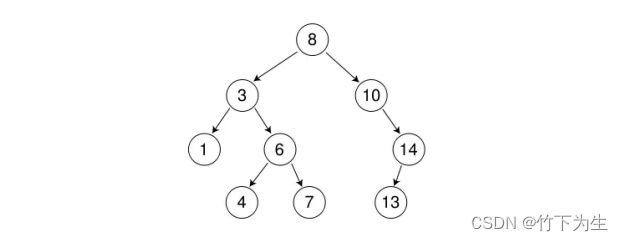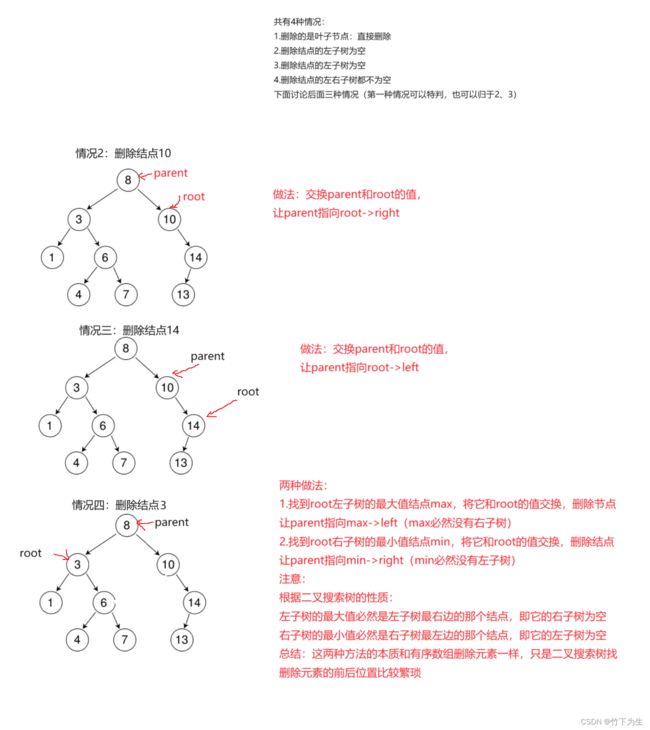C++进阶篇3---二叉搜索树(Binary Search Tree)
一、二叉搜索树的概念
二叉搜索树又称二叉排序树,它或者是一棵空树,或者是具有以下性质的二叉树:
- 若它的左子树不为空,则左子树上所有节点的值都小于根节点的值
- 若它的右子树不为空,则右子树上所有节点的值都大于根节点的值
- 它的左右子树也分别为二叉搜索树
根据二叉搜索树的性质,我们很容易看出它的中序遍历是升序,下面画一个二叉搜索树,可以试着用中序遍历遍历一遍,对二叉树有所遗忘的可以去看看二叉树详解
二、二叉搜索树的实现
//定义结点
template
struct BSTreeNode {
T val;
BSTreeNode* left;
BSTreeNode* right;
BSTreeNode(const T& x)
:val(x)
,left(nullptr)
,right(nullptr)
{}
};
template
class BSTree {
typedef BSTreeNode Node;
public:
void InOrder();//中序遍历
Node* Find(const T& x);//查找
bool Insert(const T& x);//插入
bool Erase(const T& x);//删除
private:
Node*_root;
}; 注意:下面代码涉及的递归函数都是写了两层,一层供对象调用,一层实现底层逻辑,因为_root被设置为了私有成员,而树的操作基本都需要遍历,所以通过成员函数实现对_root的使用
1.中序遍历
//这里二叉树的递归函数建议写两层,因为_root是私有成员只能在类内访问
void _InOrdered(Node* root) //该函数可以设为私有/保护,仅供类内使用,具体在场景
{
if (root == __nullptr)
return;
_InOrdered(root->left);
cout << root->val << " ";
_InOrdered(root->right);
}
void InOrdered()
{
_InOrdered(_root);
cout << endl;
}2.查找
2.1迭代
Node* Find(const T& x) {
Node* cur = _root;
while (cur) {
if (cur->val == x)
return cur;
else if (cur->val > x)
cur = cur->left;
else
cur = cur->right;
}
return nullptr;
}2.2递归
Node* _FindR(Node* root, const T& x)
{
if (root->val > x)
return _FindR(root->left, x);
else if (root->val < x)
return _FindR(root->right, x);
else
return root;
return nullptr;
}
Node* FindR(const T& x)
{
return _FindR(_root, x);
}3.插入
- 二叉搜索树中没有重复元素
3.1迭代
bool Insert(const T& x)
{
if (_root == nullptr) //为空树,直接插入
{
_root = new Node(x);
return true;
}
Node* cur = _root;
Node* parent = nullptr;
while (cur)
{
parent = cur;
if (cur->val < x)
cur = cur->right;
else if (cur->val > x)
cur = cur->left;
else//出现该值出现过
return false;
}
Node* newnode = new Node(x);
if (parent->val > x) parent->left = newnode;
else parent->right = newnode;
return true;
}3.2递归
bool _InsertR(Node*& root,const T& x) //注意这里的引用
{
if (root == nullptr)
{
root = new Node(x);//这是引用,不是变量,不用担心连接问题,本质和用二级指针一样
return true;
}
if (root->val > x)
return _InsertR(root->left, x);
else if (root->val < x)
return _InsertR(root->right, x);
else
return false;
}
bool InsertR(const T& x) {
return _InsertR(_root, x);
}4.删除(重点)
4.1迭代
bool Erase(const T& x)
{
Node* cur = _root;
Node* parent = nullptr;
while (cur)
{
int val = cur->val;
if (x < val)
{
parent = cur;
cur = cur->left;
}
else if (x > val)
{
parent = cur;
cur = cur->right;
}
else
{
if (cur->left == nullptr) //左为空
{
if (parent->val > x)
parent->left = cur->right;
else
parent->right = cur->right;
}
else if (cur->right == nullptr)//右为空
{
if (parent->val > x)
parent->left = cur->left;
else
parent->right = cur->left;
}
else//左右都不为空
{//这里采取在右子树种找最小结点
Node* L = cur->right;
Node* fa = cur;
while (L->left)
{
fa = L;
L = L->left;
}
swap(L->val, cur->val);
if (fa != cur)
fa->left = nullptr;
else//这里需要注意如果最小结点就是右子树的根结点的情况
fa->right = L->right;
cur = L;
}
delete cur;
return true;
}
}
return false;
}4.2递归
bool _EraseR(Node*& root, const T& x) //注意这里的引用
{
if (root == nullptr)
return false;
if (root->val > x)
return _EraseR(root->left, x);
else if (root->val < x)
return _EraseR(root->right, x);
else
{
if (root->left == nullptr)
{
Node* del = root;
root = root->right;
delete del;
return true;
}
else if (root->right == nullptr)
{
Node* del = root;
root = root->left;
delete del;
return true;
}
else
{
Node* subleft = root->right;//找比它大的第一个数字
while (subleft->left)
subleft = subleft->left;
swap(subleft->val, root->val);
return _EraseR(root->right, x);//将问题转化为更小的子问题
}
}
}
bool EraseR(const T& x)
{
return _EraseR(_root, x);
}三、完整版
template
struct BSTreeNode {
T val;
BSTreeNode* left;
BSTreeNode* right;
BSTreeNode(const T& x)
:val(x)
,left(nullptr)
,right(nullptr)
{}
};
template
class BSTree {
typedef BSTreeNode Node;
public:
bool Insert(const T& x) {
if (_root == nullptr) {
_root = new Node(x);
return true;
}
Node* cur = _root;
Node* parent = nullptr;
while (cur) {
parent = cur;
if (cur->val < x) {
cur = cur->right;
}else if (cur->val > x) {
cur = cur->left;
}else{
return false;
}
}
Node* newnode = new Node(x);
if (parent->val > x) parent->left = newnode;
else parent->right = newnode;
return true;
}
Node* find(const T& x) {
Node* cur = _root;
while (cur) {
if (cur->val == x)
return cur;
else if (cur->val > x)
cur = cur->left;
else
cur = cur->right;
}
return nullptr;
}
bool erase(const T& x) {
Node* cur = _root;
Node* parent = nullptr;
while (cur) {
int val = cur->val;
if (x < val)
{
parent = cur;
cur = cur->left;
}
else if (x > val)
{
parent = cur;
cur = cur->right;
}
else
{
if (cur->left == nullptr) //左为空
{
if (parent->val > x)
parent->left = cur->right;
else
parent->right = cur->right;
}
else if (cur->right == nullptr)//右为空
{
if (parent->val > x)
parent->left = cur->left;
else
parent->right = cur->left;
}
else//左右都不为空
{
Node* L = cur->right;
Node* fa = cur;
while (L->left) {
fa = L;
L = L->left;
}
swap(L->val, cur->val);
if (fa != cur)
fa->left = nullptr;
else
fa->right = L->right;
cur = L;
}
delete cur;
return true;
}
}
return false;
}
void _InOrdered(Node* root) {
if (root == __nullptr)
return;
_InOrdered(root->left);
cout << root->val << " ";
_InOrdered(root->right);
}
void InOrdered() {
_InOrdered(_root);
cout << endl;
}
Node* FindR(const T& x) {
return _FindR(_root, x);
}
bool InsertR(const T& x) {
return _InsertR(_root, x);
}
bool EraseR(const T& x) {
return _EraseR(_root, x);
}
//BSTree() {}
BSTree() = default;//强制生成默认构造
~BSTree()
{
Destroy(_root);
}
BSTree(const BSTree& t)
{
_root = Copy(t._root);
}
BSTree& operator=(const BSTree t)
{
swap(t._root);
return *this;
}
private:
Node* Copy(Node* root) {
if (root == nullptr)
return nullptr;
Node* newnode = new Node(root->val);
newnode->left = Copy(root->left);
newnode->right = Copy(root->right);
return newnode;
}
void Destroy(Node*& root) {
if (root == nullptr)
return;
Destroy(root->left);
Destroy(root->right);
delete root;
root = nullptr;
}
bool _EraseR(Node*& root, const T& x) {
if (root == nullptr)
return false;
if (root->val > x)
return _EraseR(root->left, x);
else if (root->val < x)
return _EraseR(root->right, x);
else
{
if (root->left == nullptr)
{
Node* del = root;
root = root->right;
delete del;
return true;
}
else if (root->right == nullptr)
{
Node* del = root;
root = root->left;
delete del;
return true;
}
else
{
Node* subleft = root->right;//找比它大的第一个数字
while (subleft->left) {
subleft = subleft->left;
}
swap(subleft->val, root->val);
return _EraseR(root->right, x);
}
}
}
bool _InsertR(Node*& root,const T& x) {
if (root == nullptr) {
root = new Node(x);
return true;
}
if (root->val > x)
return _InsertR(root->left, x);
else if (root->val < x)
return _InsertR(root->right, x);
else
return false;
}
Node* _FindR(Node* root, const T& x) {
if (root->val > x)
return _FindR(root->left, x);
else if (root->val < x)
return _FindR(root->right, x);
else
return root;
return nullptr;
}
private:
Node* _root = nullptr;
}; 
